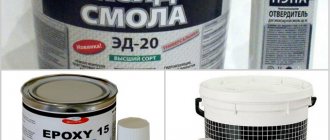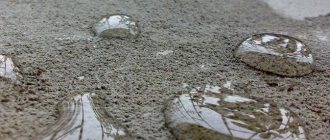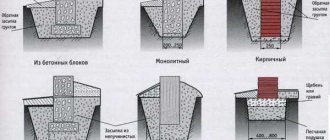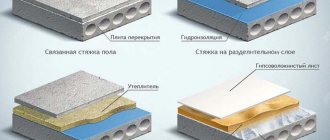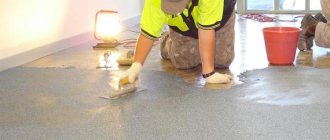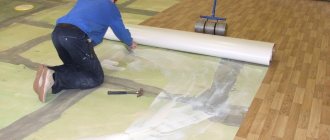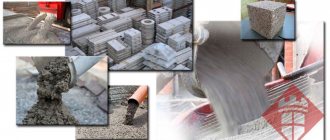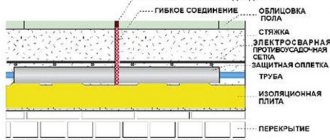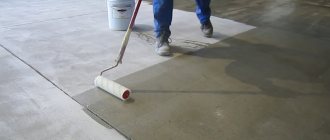Repair compounds for concrete can eliminate deformations and chips in structures. The products are used in different seasons, withstand changes in temperature conditions, are resistant to high humidity, the effects of fungus and mold, have good adhesion and rapid setting of the composition.
The list of popular products includes products from the brands Emaco, Consolit Bars, Birss, Siltek, Knauf, Mapei.
Difficulties of the concrete repair process
Repair of concrete surfaces using mortar or dry mixtures is required when the reinforcement is exposed, the material is destroyed, or the surface cracks down to the crushed stone filler. In the absence of restoration work, the structure may collapse.
There are the following difficulties in repairing concrete structures:
- cement grain has a dense structure and does not absorb liquids, solutions, standard masonry composition does not adhere to the base;
- The typical repair mixture shrinks and peels off on a concrete base.
To restore the integrity of the surface, specialized mixtures are used that are characterized by plasticity, a high degree of adhesion, and strength.
The product formula includes the following basic principles:
- dry polymer-cement and ready-made compositions;
- fibropolymer compounds consisting of sifted sand, acrylic and cement;
- compositions with epoxy resins.
Cement mortars
These compounds are very popular due to their low cost and ability to repair minor shrinkage cracks in concrete.
Repairing a crack
Before you begin sealing, you need to check the crack itself for chips around it. If there are any, then in the near future they may turn into holes, so it is imperative to remove all peeling pieces of concrete. After this you need:
- Perform jointing. To do this, using a chisel and a hammer, you need to walk along the entire length of the crack so that its depth is at least 5 mm. If necessary, you can use a spatula to create a depression.
- Remove dust using a vacuum cleaner and rinse the resulting depression with water.
- Remove excess water and cover the crack with cement mortar (3 parts sand to 1 part cement with the addition of PVA). In this case, you need to ensure that the composition covers the entire space of the recess.
- Moisten the poured cement with water.
We invite you to familiarize yourself with the Wire diameter by cross-section table and currents
Filling the hole
If a hole has formed in the concrete surface in which the reinforcement is visible, the defect can be repaired as follows:
- Clean the hole in the concrete and treat its surface with an anti-corrosion compound.
- Place pieces of steel wire about 4 mm in diameter into the recess.
- After this, the recess is covered with a primer, applying it evenly over the entire surface. In this case, the thickness of the mixture layer should be about 3 mm.
- Without waiting for the mixture to dry, fill the hole with a cement compound for sealing cracks in concrete and make sure that it fills the entire hole. If the hole is too deep, then cement is poured in several stages. In this case, each subsequent layer must be moistened with water from a spray bottle.
- Level the surface with a lath (metal or wood), moving the tool from right to left.
- After the mixture has hardened, excess cement composition must be removed with a spatula and the surface must be plastered. If the crack was too deep, then leveling is done using a grinding machine.
Healthy! The cement composition must be poured with a reserve so that it is slightly higher than the floor surface. The mixture will shrink as it hardens.
After 24 hours, the concrete floor can be painted or any finishing material can be laid on it.
However, it is worth considering that such sealing of cracks in concrete will not provide a sealing effect and is not suitable for surfaces that have increased waterproofing requirements. In addition, the cement composition can be considered as a temporary solution to problems. Sooner or later the defects will appear again.
When deciding how to repair cracks in concrete, such materials are most often considered. They are affordable, easy to prepare, and durable, provided the solution mixing technology is followed. With their help, you can fill shrinkage leaks, which are characterized by a small width. It is important to properly prepare the base surface. This will ensure high adhesion of the cement mortar to concrete.
Repairing a crack
Regardless of what materials you plan to use to fill the gap, the preparatory stage is always the same. Thus, it is recommended to joint the deformed area. If it is filled with a mixture for sealing cracks in concrete without preparing the base, then as a result the mortar layer will be deformed. You need to follow the instructions:
- Check the edges of the crack for strength. If the concrete in these areas has crumbled, it is removed. The jointing is carried out along the entire length of the gap. Its width after removal of exfoliated concrete should be 5 mm or more. Work at this stage is carried out using a chisel and a hammer. You can use a spatula.
- The surface is cleaned of dirt.
- Remove dust using water. In addition, moistening the crack will improve the adhesion of materials when applying the solution.
- Remove excess liquid.
- A cement-sand mixture is being prepared. You will need sand (3 parts) and cement (1 part). To increase the strength of the solution, PVA glue is added.
- Fill the crack with the mixture. It is important that the solution covers the entire surface of the concrete in the recess.
- While the cement dries, it is periodically moistened with a small amount of water.
Filling the hole
To repair a large crack or hole in a concrete wall, follow the instructions:
- The resulting hole in the coating is cleaned of contaminants and the crumbling material is removed.
- An anti-corrosion compound is applied to the walls and bottom of the hole. This need is due to the fact that there is reinforcement inside, which will begin to oxidize upon contact with moisture.
- The wire is being laid (the diameter can be 4 mm or more). It is cut into pieces, the length of which must correspond to the diameter of the hole in the concrete.
- The surfaces are treated with a primer composition, which will ensure increased adhesion of materials. A layer thickness of at least 3 mm is considered sufficient.
- Filling of leaks is carried out immediately after treating the surfaces with a primer. Then the coupling will be the best. If the hole is shallow, it can be filled immediately. In cases where it is large enough, restoration of the coating is carried out layer by layer with breaks for treating the solution with water from a spray bottle.
- The surface is leveled. To do this, use a rail. Movements are performed from side to side.
- When the mixture has set a little, remove its excess.
- The surface must be covered with a plaster composition. This will provide additional protection. Deep holes are leveled with a grinding machine.
It must be taken into account that the cement mixture is subject to shrinkage during the drying process. This will lead to slight subsidence of the solution layer. To avoid such consequences, it is recommended to use a little more mixture when filling the crack. The described method is suitable only for cases where it is not necessary to ensure the tightness of the coating and there are no increased requirements for surfaces.
In addition, cement compositions cannot be considered as an effective measure providing long-term results. The coating will soon continue to deteriorate. This means that the cement composition should be used only as a temporary measure.
Classification
Repair composition for sealing cracks in concrete is divided into the following types:
- injection molding;
- dry.
To adjust the characteristics, plasticizers, granular fillers, modifying additives, etc. are added to the mixture.
According to the complexity of the composition formula, products are divided into the following subtypes:
- one-component - cement-based with filler of different granularity levels;
- two-component - epoxy differ in the degree of density, ductility and fluidity;
- multicomponent - based on polyurethane, have a liquid consistency.
According to the level of compression, products are divided into the following subtypes:
- shrinkage;
- non-shrinkable.
According to their functional purpose, the following subtypes are provided:
- for structures with high mechanical loads - ceilings, load-bearing wall panels, beams, pillars;
- compositions for protecting reinforced concrete structural elements from corrosion, the appearance of fungus, and damage from mold;
- Products with increased strength for the restoration of road surfaces and building screeds provide additional protection in winter.
According to the conditions of use, products are divided into the following subtypes:
- casting - for horizontal surfaces;
- thixotropic - for correcting unevenness on wall panels;
- frost-resistant - for external repair work;
- quick-hardening - for urgent repair work, eliminating leaks.
Fast acting mixture
Fast-acting concrete repair mixtures harden and dry quickly. The use of heavy loaders is permitted 30 minutes after application of the composition. The mixtures are suitable for a concrete layer no larger than 40 mm. The materials are used for emergency repairs in warehouses, in places where equipment is not allowed to remain idle.
Non-shrink repair product
Shrinkage occurs when the volume of cement stone in the solution decreases during the evaporation of water from the adhesive composition. Deformations can lead to the formation of cracks and chips. A special non-shrinking composition prevents destruction of the concrete base.
The formula of the product includes additives with a special reagent to expand the mass.
The solution is plastic, does not separate, does not shrink and sets quickly. The compositions are suitable for different types of bases, are strong, durable, and are highly expensive.
Thixotropic mixture
The thixotropic mixture is intended for repairing blocks, wall panels on a slope, and horizontal surfaces. When using the product, no auxiliary lathing is required; the product has a high viscosity that prevents spreading outside the treated area.
The dry mixture is based on durable cement powder, mineral fillers, and modifying agents. The mass also includes reinforcing fibers.
After dilution in water, a strong solution is formed that does not create shrinkage. The thixotropic mixture must be applied in a dense layer. For stability in places with heavy loads, reinforcing bars will be required. After hardening, the composition becomes resistant to compression and bending, and vapor permeable.
The product is intended for professional repairmen and restoration work in private buildings.
When used professionally, the mixture is suitable for the following areas and types of structures:
- restoration of damaged surfaces, structural repairs in the event of reinforcement corrosion;
- to eliminate defects that arose during construction;
- to restore the protective layer;
- for filling thin seams;
- for leveling wall panels and fences;
- for mounting foundations exposed to strong mechanical loads;
- for waterproofing work on the roof;
- for repairing boiler houses, thermal power plants, bridges, chimneys, viaducts;
- for restoration of ceilings in basements.
In private construction, compositions are used in the following cases:
- repair of concrete floors, paths, floors, staircases, basements, vegetable stores;
- sealing cracks, chips, grooves;
- restoration of garages;
- repair of structures subject to dynamic loads.
Thixotropic repair materials are not used for finishing smooth surfaces and are not suitable for anchoring or preparing formwork. The installation temperature must exceed +5°C. The thickness of 1 coating reaches 30-35 mm, after 28 days the compressive strength reaches 60 N/mm², elasticity parameters are 25,000 N/mm².
Frost-resistant
Frost-resistant compounds are used to repair concrete outdoors. The product can withstand sub-zero temperatures and temperature changes. The formula of the mixture contains polymer compounds, minerals, fractionated sand, modifying fillers, Portland cement, etc.
The product is used for repairing brick and concrete buildings, cracks in floors, technological holes, restoring smoke, boiler houses, thermal power plants, prefabricated reinforced concrete structures, plinths, for waterproofing building foundations, eliminating defects in monolithic structures, etc.
Modern materials for repairing concrete products
It is not worth restoring concrete and repairing it with a regular cement-sand mixture. The repair solution must provide maximum characteristics of strength, reliability, adhesion, plasticity, thixotropy, since in this case the design is not simply created using technology, but errors, defects are eliminated, knots are connected, there is exposure to increased loads, etc.
If we consider domestic manufacturers of universal mixtures that can be used to repair and protect concrete, then Penetron-Russia materials are considered the best on the market. The most popular compositions are “Skrepa M700 Structural” and “Skrepa M500 Repair”.
Main properties and advantages of these materials:
- Minimum setting time.
- High level of compressive strength, which is ensured already in the early stages.
- Thixotropy, plasticity, workability.
- High levels of frost resistance, water resistance, and wear resistance.
- Good adhesion to concrete.
- Durability and corrosion resistance.
- Complete absence of shrinkage.
Due to these properties, the repaired and restored section of the structure, after quick setting, immediately begins to work along with the other parts of the monolith as a single whole. In the shortest possible time, the original load-bearing capacity is restored, which allows the structures to continue to be used without the need for dismantling and replacement.
The structural composition demonstrates higher performance and values, therefore it is used in the most severe cases and critical structures. So, for example, the material is used in work with bridge spans. The composition makes it possible to restore the geometric shape of structures even in the presence of serious damage and defects.
The scope of application of these two solutions covers almost all areas of construction: they are used to repair structures and structures for various purposes (including bridges, cooling towers, tunnels, oil product storage facilities, sewage treatment plants, water storage tanks, concrete docks, emergency and civil defense structures, and etc.).
In private construction and repair of unloaded structures, mortars mixed on the basis of high-strength cement with special complex additives are often used; fiber-reinforced concrete, polymer solutions, quick-hardening cements, etc. are also relevant. The most important task is to ensure the desired structural characteristics and achieve high adhesion between the main structure and the repaired area.
Techniques can be used to enhance the bond between old/new concrete. If there is significant damage to the surface, the base is filled with new concrete, having previously cleaned the area to a durable monolith.
Ordinary heavy concrete is suitable for partial/full repair of structures, when applying repair compounds in a layer of more than 10 centimeters, in pouring solid reinforced concrete jackets.
The area that needs to be concreted again is buried and made of sufficient thickness. It is advisable to reinforce it with steel mesh by shooting it to the base with dowels or firmly fastening it by other methods. Old concrete is thoroughly cleaned and washed, exposing the filler grains and making the surface rough. An additional layer can also be made to increase adhesion (cement adhesives, epoxy compositions, polymer acrylics and others).
Main types of repair compounds:
- Dry mixes (BIRSS, Knauf, Osnovit, Emaco) - are prepared on the basis of cement, are compatible with concrete, and allow for high-quality repair of any structure. The thickness of the repair layer per application can be 5-50 millimeters for horizontal/vertical bases, on the ceiling - up to 30 millimeters. Works best with primers and primers. Suitable for structural repairs of concrete/reinforced concrete structures at temperatures above +5 degrees, they protect and waterproof. They are used for sealing defects, expedited repairs, and in the repair of industrial floors and road surfaces, joints. Advantages: maximum adhesion and compressive strength, no shrinkage, ability to eliminate defects up to 10 centimeters deep, speed. Disadvantages: high cost, short shelf life.
- Thixotropic compositions (BASF, MAPEI, Sika) are dry mixtures made on the basis of high-strength cement and fractionated sand, and special additives. The most effective are compositions with polymer fiber. The composition can be used without formwork on horizontal, vertical, ceiling planes. After hardening, it turns into high-strength concrete and can be applied in layers up to 35 millimeters. Used for repairing precast/monolithic concrete, bridges, viaducts, tunnels, canals, protective layers, joints, objects for various purposes. Pros: wear resistance, high adhesion, water resistance, frost resistance. Disadvantages: can only be used at positive temperatures, high cost.
- Mixtures based on epoxy resins and other polymers (Technoplast, Elakor, KrasKO) are used in various types of repairs and are relevant for injection to protect concrete from various influences. Elastic, semi-rigid, rigid compounds are used in the work. For polymers, concrete must be prepared and primed. The products are applied using polyamide rollers or a smooth spatula; it is also possible to use special equipment (injection method). The compounds seal chips and cracks and increase water resistance and strength. Two-component mixtures are used to restore load-bearing capacity, repair cracks, create an adhesive layer, localize leaks, etc. Pros: good mechanical/chemical resistance, fire safety, high adhesion, waterproofing. Cons: low viability.
- Repair and secondary waterproofing of concrete (Protexil, SCHOMBURG) - used to protect structures and elements from operating conditions. There are two types: hydrophobic impregnations (silaxane, silane, polysilaxane) to act on the surface and give it water-repellent properties, as well as polymer- and mineral-based impregnations to strengthen and reduce the porosity of the stone.
Manufacturers
The list of popular repair compounds includes products from the following manufacturers:
- Ceresite;
- Penetron;
- Basf;
- Birss;
- Consolidated Bars;
- Siltek;
- Knauf;
- Industry;
- Mapei.
Ceresit
The manufacturer Ceresit produces different types of building mixtures for concrete foundations. The Ceresit CX5 mixture is a restorative mixture, suitable for repairing concrete structures at high humidity. The product does not shrink significantly when hardened and used, and can withstand changes in temperature conditions. The coating is resistant to high humidity and reliably hides defects. The cost of the composition is high - about 2500-3000 per package of 25 kg.
The composition of Ceresit CN 88 is intended for leveling floor coverings and is durable. The product is laid out in a layer of 5-50 mm and can be used indoors and outdoors. The mass is quickly leveled, the surface can be used 6 hours after restoration. The product is wear-resistant, suitable for mechanized spraying, and environmentally friendly in composition.
The product is suitable for leveling screeds and restoring foundations that can withstand high loads. The mass is suitable for manual application to the coating.
The minimum layer thickness is no less than 35 mm; on the sound and heat insulating layers, the product is laid out with a thickness of no less than 45 mm. Can be used as a base for laying finishing material.
Penetron m500 bond mixture
Concrete repair compositions from the Penetron brand are dry mixes. The formula contains processed quartz sand, fine-grained Portland cement, polymer compounds to improve the elasticity of the product, and mineralized fiber fibers. The mixture must be diluted in the proportions of 170 g of water per 1 kg of powder. Laying the mass is carried out at a temperature of at least +5°C. The surface must be washed with clean water.
The product is laid out in a thickness of 5-35 mm, consumption is carried out in proportions of 1.8 kg per 1 m². The composition can be laid out in several layers, the second coating is applied after 4 hours. It takes 120-150 minutes for the layer to harden. After 28 days, the patch increases water resistance to W14, the strength category is 50 MPa, the adhesion level is up to 1.3 MPa.
Blend Parade
Parad brand compositions are intended for urgent repairs of concrete structures; the coating thickness can reach 60 mm. Laying can be done at a temperature not lower than +5°C. The advantage of the product is the rapid setting of the composition and the high strength of the patch.
After 1 day, the strength of the layer reaches 20 MPa; after 1 month, the coating acquires a strength parameter of 70 MPa, the frost resistance level is F200.
The product is universal, suitable for different types of structures (anchors, foundations, joints, road slabs, hydraulic structures, drinking water tanks).
Emaco
Repair mortar for concrete floors Emaco brand Basf is used for structures of various levels of complexity. Emako N 5100 is suitable for minor deformations (cracks, chips). Products N 900 and N 5200 are suitable for eliminating defects of medium complexity (cracks, collapsed areas).
Products S 5400, S 488 are used to eliminate damage due to the corrosion process, closing cracks up to 40 mm. The company also offers compositions for damaged concrete surfaces with exposed reinforcement bars and large chips.
The manufacturer has developed frost-resistant, non-shrinking, anti-corrosion compounds. The price in Moscow is 850-1800 rubles. for 1 package.
Birss Russia
The concrete repair mixture from the Birss brand is universal and can be used for surfaces of different levels of complexity. Products 28, 29, 30, 30N are applied to eliminate cracks and deformed coatings. Special products (30С1, 59С2 and 58С1) are intended for medium wear surfaces; mixtures 59S3, 59Ts, RSM, RBM, 600VRS are used in case of major damage to structures.
The compositions have frost-resistant characteristics, are used at sub-zero temperatures, have high strength of bonding of elements, have water-resistant characteristics, high density, and plasticity.
Consolid Bars
Products for surface restoration Consolit Bars are suitable for panels located vertically and on floor coverings; the mass quickly holds surfaces together, does not shrink, and has high adhesion. The product line includes self-leveling, thixotropic (for restoration of wall panels), finishing, waterproof and reinforcing mixtures. The cost of production is 800-1500 rubles. per package 30 kg.
Knauf
Products for concrete repair from the Knauf brand are environmentally friendly, do not contain toxic substances, are durable, provide surface waterproofing, and have water- and vapor-proof characteristics. The mixtures are sold in compact packages (5-6 kg). The products are universal and are used for external and internal repair work. The cost of packaging (5 kg) is 350-500 rubles.
Industry
Indastro products are universal and are used for repairs, restoration of structures on foundations, restoration of road surfaces, etc. The composition ensures strong joining of elements, is durable, wear-resistant, does not have strong shrinkage, is water-resistant, and frost-resistant.
Mapei (Italy)
The mixture from the Mapei brand ensures that restoration work can be completed in a short time, does not shrink during hardening, does not deform, and prevents abrasion of surfaces. The special SW series is suitable for reinforced concrete structures and is resistant to temperature changes, precipitation and moisture. After hardening, the coating layer acquires anti-corrosion properties and is suitable for waterproofing work.
The manufacturer's range also includes mixtures:
- epoxy;
- with the addition of resins;
- with high plasticity;
- for repairing cracks;
- for restoration of ceilings;
- for repairing airfield ceilings, tunnels, production workshops, highways.
The product price is about 850-1500 rubles.
Mount Crystal
Mountain Crystal products are intended for the reconstruction of concrete floor surfaces, reinforced concrete floors, walls lined with foam concrete and aerated concrete blocks. The mass is used to seal cracks and placed in areas of chips, holes, voids and traces of erosion. The product is suitable for restoring walls, floor coverings, and ceilings.
Siltek
The manufacturer Siltek offers a composition for repairing defects in surfaces and finishing seams between panels. The materials are frost- and water-resistant, quickly harden, durable, and wear-resistant. Reinforced microfibers are included in the formulas of some products. Products are certified.
The particle size in the mass reaches 2.5 mm, the thickness of the coating reaches 30 mm, after 3 days the strength of the layer reaches 15 MPa, after 28 days - 35 MPa. The product is suitable for use within 30 minutes after dissolving in water.
Frost resistance parameters reach at least 200 cycles, shrinkage does not exceed 1.2 mm/m, abrasion characteristics do not exceed 0.5 g/cm2.
The permissible operating temperature is -30…+70°С. After 3 days, the bending strength parameters reach 3 MPa, after 28 days - no less than 5 MPa. The strength of bonding to the surface is not less than 2.0 MPa.
Manufacturers of repair mixtures
Repair mixture for concrete "Emako" is produced in Russia. It is used to restore concrete structures that have serious or minor damage. This composition is capable of eliminating five different degrees of damage.
The first degree involves the presence of shells, shrinkage cracks, and contamination. The maximum depth of damage is 5 millimeters. To eliminate such errors, you should use a mixture of the Emaco N 5100 brand.
The second degree of damage involves peeling of the surface and the presence of minor chips. In order to get rid of such shortcomings, you should use compositions of the Emaco N 900 and Emaco N 5200 brands.
The third degree involves the occurrence of cracks within 1-2 millimeters and rust. The maximum depth of damage is 40 millimeters. If you choose repair mixtures for restoring concrete with such errors, then it would be best to purchase compositions of the Emaco S 488 PG, Emaco S 5400 and Emaco S 488 brands.
The fourth degree is cracks that are larger than 0.2 millimeters. In this case, exposed reinforcement may appear and carbonization may occur. The maximum depth of damage is 10 cm. It is best to purchase Emaco T1100 TIX, Emaco S560FR or Emaco S 466 mixtures to eliminate such damage.
The most recent damage is grade five. In this case, the reinforcement may be exposed, and there may be deep cracks on the surface. The depth of the damage exceeds 20 cm. The Emaco Nanocrete AP mixture will help protect the reinforcement from the effects of corrosion. If you decide to use the above-mentioned brands of repair compounds, then you will have to pay from 13 to 26 dollars per 25 kg.
How to choose?
When selecting products, the following parameters must be taken into account:
- type of repair required;
- extent of damage;
- permissible loads on the base;
- location (indoor or outdoor);
- safety, no toxic particles;
- thickness of the mass laying layer;
- volume of raw materials;
- level of protection against ultraviolet radiation;
- shrinkage characteristics;
- resistance to chemicals and sub-zero temperatures.
When choosing the type of product, it is important to consider the following recommendations from experts:
- it is better to strengthen panels located vertically with thixtotropic mixtures, since the products have a thick consistency and hold securely during operation;
- compositions for leveling the surface must have a high adhesion rate;
- The setting period of the mass should be short.
Use of sealants and self-expanding tapes
- Repair options
- Technology Methods of reconstruction work
Concrete coatings have long gained popularity among consumers due to their durability.
They are used not only for the manufacture of floors in production workshops or as road surfaces, but also in private housing construction.
This material will talk about how to seal cracks in concrete, which are often a coating problem.
DIY concrete floor repair
Their appearance is associated with:
- low tensile strength of the material, when when the structure dries, it contracts and shrinks;
- mechanical and chemical damage to the coating;
- temperature changes;
- corrosion of reinforcement.
Advice: it is necessary to repair any cracks as quickly as possible, regardless of the reasons for their appearance. This is one of the main tasks that can prevent further destruction of the structure.
Repair options
| Industrial method | |
| Injection | It is necessary to introduce polymer materials into cracks and voids, injecting them there using “injections”. This method makes it possible not to partially replace the concrete structure. It is often used when deciding how to repair cracks in a concrete wall. |
| Special repair composition for sealing cracks in concrete | In this case, the damaged surface is treated with a solution consisting of a cement-sand mixture and a polymer additive (furyl alcohol and sulfanol). After it dries, it is necessary to apply polyurethane sealant on top. |
| Shotcrete | Damaged areas are treated with the same material. An additional layer is applied to the surface, consisting of: water; cement; fractionated sand; organic additive (bitumen, resin, latex). Remember, this method increases the mass of the structure, thereby creating additional pressure on the foundation. |
At home they use:
- Cement liquid “dough” - for cracks whose dimensions do not exceed 3 mm.
- Compositions with epoxy resin.
- Special repair mixtures.
Tip: if the size of the cracks exceeds 3 mm, use a special mixture (Portland cement 1 part, water and sand - 3 parts each, as well as PVA glue).
There is also such a concept - self-healing of cracks, which implies their spontaneous filling. Typically, the method only works for very small defects no larger than 0.1 mm in size.
Cleaning the defect area
Technology
Below you will find instructions that will help you understand the entire cycle of work.
You should first prepare the tools and materials:
- hammer;
- chisel;
- cement;
- sand;
- PVA glue;
- water;
- brush;
- putty knife;
- mittens;
- paint brush;
- trowel;
- wooden slats;
- pieces of wire;
- metal smoother;
- sander.
Tip: if you forgot to leave technological channels in the foundation, floor or walls, diamond drilling of holes in concrete with crowns of the required diameter will help you.
Now you will learn how and with what to repair cracks in a concrete floor and not make mistakes when using the composition:
- Conduct preliminary preparations for the work site. To do this, check the crack itself and the area next to it so that there are no chips on it, which in the future may become shallow pits.
- Before repairing cracks in concrete, take a chisel and hammer and go along the entire length of the defect to open it up.
Joining the defect
Advice: if a hidden chip is detected, this piece of concrete should be removed.
- Clean the surface with water, a brush and detergent. You can use a vacuum cleaner to remove dust from the crack. Remove any remaining water with a sponge.
- Take a spatula and deepen the defect to about 5 mm, then the cement-lime mortar will be able to fill the entire space of the cracks and will hold firmly and for a long time.
The photo shows a cement-lime mixture for sealing cracks in concrete
- Prepare a solution by taking 3 parts sand, 1 part cement and add PVA glue to the mixture. Please note that the solution should not be thick or liquid.
- Take a trowel and pour the mixture into the crack, then moisten it with water.
Tip: if you are using a polymer composition, there is no need to moisten it with water.
If the cracks in the floor are of medium size and reinforcement is visible from them, they must be cleaned and treated with a solution that protects the metal from corrosion. You can also put pieces of wire of the same length and Ø4 mm into the grooves.
Using a trowel
- Apply the adhesive compound with a brush and spread it over all uneven areas. In this case, the layer thickness should be about 3 mm.
- Fill them with the solution without waiting for the composition to dry. Try to fill gradually, then the solution will lie more densely.
- Use a wooden lath to level the surface, removing the excess layer of mixture from it.
Tip: if the defect is very deep and large, apply the solution in several layers, wetting each with a small amount of water.
You can lay laminate flooring or paint a concrete surface literally within 24 hours, but you should not rush into gluing ceramic tiles.
Be sure to remember the following rule - the filling layer must be higher than the floor level, the solution will shrink after drying. Carry out subsequent work using a concrete grinder.
Tip: cutting reinforced concrete with diamond wheels will help you widen a large crack in the floor, after which the process is similar to working with medium-sized defects.
You can also seal a crack in a concrete floor using an elastic sealant, among the variety of which silicone is the most widely used. It is used to repair defects of various sizes.
How to Seal Cracks in Concrete Floors with Flexible Sealant
The process is no different from working with CIS. You will also need to clean out cracks or make additional grooves.
Tip: When applying sealant, it is necessary to moisten the surface.
Its main advantage is its drying speed, which is much faster than that of cement-lime mortar. But, the price of this method will also be higher.
We suggest you familiarize yourself with How to improve the stove in your home
Today you learned the best and fastest way to repair cracks in concrete, and also that repairs must begin as soon as possible, otherwise further destruction of the surface area may occur. This will increase the cost of the process several times (see also the article “Pouring concrete in winter: disadvantages and advantages”).
This article proposed two main methods for dealing with defects in concrete floors and walls.
This article will help you find additional information on this topic.
Filling a crack in concrete with sealant.
The use of epoxy compounds is justified for filling cracks, but if you need to restore the coating on which a hole has appeared, and it is also affected by moisture, in this case it is better to consider elastic mixtures. Sealant is most suitable for this purpose. This composition has a significant drawback - its high price. However, there are a number of positive qualities:
- versatility: the sealant can be used to fill gaps of different sizes;
- compaction, sealing when sealing cracks in concrete, which allows the coating to come into contact with water without the risk of destruction;
- it is possible to apply sealant at temperatures below 0°C;
- ease of use;
- high speed of work completion.
This material is used in conjunction with a self-expanding tape or cord. Additionally, prepare a glue gun, chisel, and brush. The type of sealant and tape or cord is determined taking into account the parameters of the gap. For a leak 60 mm deep, use a 18x23 mm cord. Instructions for restoring the coating:
- The gap is widening.
- After removing the crumbling layer of concrete along the edges of the crack, they proceed to cleaning its internal surfaces.
- No primer treatment is required. Immediately lay the tape along the side walls of the embroidered gap.
- The remaining space is filled with a compound for sealing cracks in concrete. To do this, use a glue gun.
- If part of the solution protrudes above the surface of the concrete coating, it is leveled with a spatula and the excess is removed.
It’s worth saying right away that this method of sealing defects is very expensive, so it is most often used when repairing concrete bowls of country pools. However, despite its high cost, the use of sealant and self-expanding cords has its own advantages:
- the ability to process any type of defect;
- complete tightness;
- the ability to carry out installation work in cold weather conditions.
To work, in addition to the standard set of tools, you will need:
- mounting gun;
- self-expanding tape or cord;
- chisel and brushes;
- sealant for concrete.
However, before covering up the flaw, you need to measure the dimensions of the cracks and purchase the right type of sealant and tapes depending on this. For example, if the hole depth is 60 mm, then an 18 x 23 mm cord will do.
The next step is necessary:
- Expand the cracks and remove dust.
- Install the cord into the recess.
- Fill the remaining space with sealant.
- Smooth out the protruding compound using a spatula.
After completing the work, you won’t have to guess how to putty the surface or caulk it. It is enough just to apply the composition and smooth it out.
If we talk about the best compositions of this type, the most popular are:
- Domestic ELASTOSIL PU 20 costs 280 rubles per 600 ml.
- The composition is from the French manufacturer Rubberflex, which today sells for 300 rubles per 310 ml.
- PLOW tape made in Russia costs about 260 rubles per linear meter.
This method is suitable for repairing defects that occur on the surface of swimming pool bowls, for restoring external walls and monolithic foundations. Stages of repair work:
- Cutting a crack, removing weak elements and dust.
- Measuring the width and depth of the crack.
- Selecting a suitable self-expanding cord or tape.
- Laying the cord or tape into the prepared cavity.
- Fill the remaining space with polyurethane sealant using a mounting gun.
A significant advantage of this method is the ability to carry out work at subzero temperatures.
Application practice
Concrete structures are destroyed if the proportions of substances are not observed, manufacturing technology is violated, due to mechanical deformations, or exposure to the external environment.
The use of special compounds is required in the following cases:
- chips;
- recesses;
- holes exposing reinforcement;
- cracks larger than 0.5 mm;
- intensive dust formation;
- corrosion process in the foundation (deep or surface);
- defects larger than 0.3 mm.
Types of cracks and other defects in concrete
Cracks appear on large and small construction sites that are subjected to increased loads or collapse under their own weight, located in moderate or extreme climatic conditions. Defects are classified according to several criteria:
- Through and superficial, which can be deep and shallow.
- In width - cracks in concrete can be hairline (up to 1 mm), medium (1-10 mm), wide massive (over 10 mm).
- In relation to reinforcement - with its partial or complete exposure or without exposure of reinforcing bars. The latter option is possible if the defects are located along the edges of the structure or between reinforcing elements.
- By location - local, over the entire surface, at the edges and corners.
- By time of appearance - primary cracks formed during hydration or during shrinkage processes in concrete, and secondary cracks that arose during operation.
- In terms of impact on the integrity of the object - no effect, reducing strength (5-50%), destructive (decrease in the level of structural strength exceeds 50%).
The choice of pouring technology depends on the size and nature of cracks in the concrete.
When starting to repair cracks, first determine how you will do it. In most cases, thin cracks in concrete are simply primed, plastered, or painted on top.
Sealing of cracks is carried out mainly by filling the depth with synthetic mixtures with the addition of resins, which have low viscosity. Holes are drilled along the crack; they must be placed diagonally, towards the defect. After this, bushings are placed in the holes and the working mixture is pumped through them.
When deciding how to repair cracks in concrete for a long time, you should pay attention to this method of treating defects. Resin and sealing mixtures based on it are suitable for restoring screeds, blind areas and various concreted areas or horizontal surfaces.
Repairing cracks in concrete using such compounds has a number of advantages. First of all, this is the low cost of the mixtures, as well as their quick drying. On the other hand, the resin allows you to securely fix the seams and keep them from subsequent enlargement.
So, to eliminate defects you will need to prepare:
- angle grinder and diamond-coated discs;
- vacuum cleaner;
- spatulas and a trough for diluting the composition;
- primer composition for concrete;
- Epoxy (base A and hardener B);
- Fine-grained sifted sand.
Before you repair a crack, you need to clean it of dust and dirt. After this, we carry out the sealing in the following sequence:
- We repair the crack. In this case, the width of the resulting recess must be at least 5 mm.
- Using a grinding machine, we cut transverse seams in the concrete in increments of 400 mm (the length of the grooves is about 100-150 mm).
- We remove the loose layer of concrete and remove dust from the surface using a vacuum cleaner.
- We treat the surface of the defect with a primer, and fix the transverse grooves using repair brackets.
- We prepare a solution from resin (base), hardener and sand according to the instructions on the packaging with the composition.
- We fill the defect with the resulting mixture and quickly level the surface, since the setting time of the resin is only 10 minutes.
After this, it is recommended to fill the surface with sand, which will need to be removed with a vacuum cleaner before plastering the base or covering it with finishing material.
We invite you to familiarize yourself with Laying expanded clay concrete blocks with your own hands
If we talk about the best materials for repairing cracks in concrete walls and other surfaces, the most effective today are considered to be:
- Domestic epoxy resin ED-16 and ED-20 costs about 2,000 per 3 kg. The hardener will have to be purchased separately (costs about 300-500 rubles).
- Epoxy 520 resin from the Czech manufacturer Spolchemie costs 3,500 rubles per 5 kg.
- German composition UZIN KR 416, which will cost 2,700 rubles per 0.75 kg.
Also very popular are compositions from the Italian manufacturer Sika.
However, it is worth considering that this method of correcting defects is not suitable for treating holes that form in concrete foundations under strong pressure from water. In this case, it is worth using a sealant.
When it is necessary to restore a concrete coating with a guarantee of a long period of operation without further destruction, resin-based compositions are considered. They are characterized by good adhesion, increased strength, and do not allow cracks to increase in size. In addition, such mixtures are versatile. Another advantage of sealing cracks in concrete floors and walls using this method is the rapid drying of the composition.
Prepare tools and materials:
- containers for preparing the solution;
- spatulas;
- grinding machine, diamond-coated discs;
- vacuum cleaner;
- primer;
- resin-based composition;
- fine sand.
Sequence of actions when repairing concrete pavement:
- The crack is being repaired. At this stage, use a chisel and a hammer to remove deformed areas of the coating along the crack. The recommended leak width is 5 mm or more.
- To strengthen the coating, transverse grooves are created in this area using a grinding machine and a diamond disc. They should be located in increments of no more than 400 mm. The length of each groove is up to 150 mm. Their width corresponds to the thickness of the diamond blade.
- Use a vacuum cleaner to remove dirt and construction dust.
- The grooves are fixed using special brackets.
- The side surfaces of the crack are treated with a primer. Without this material, sufficient adhesion strength will not be ensured.
- Considering that the epoxy resin mixture hardens quickly, it is necessary to prepare it immediately before use. The composition must contain sand and a hardener, in addition to resin. The ratio of components is indicated in the mixture manufacturer's instructions.
- The crack is filled with epoxy resin. Hardening time: 10 minutes.
- When the gap is filled, sand is sprinkled on top of the mixture. It is removed before finishing work.
Epoxy resins for sealing cracks in concrete.
Self-production
You can make a repair composition for concrete yourself for work on the arrangement of a private house, outbuildings, etc.
You will need to mix the following components:
- 1 part cement powder;
- 3 parts clean fine sand;
- glue (PVA or Bustilat) with water in proportions 1:3.
You need to mix sand and cement powder, mix with other ingredients and prepare a homogeneous mass. When mixing, use a special mixer. The composition is prepared on the eve of work to prevent pre-hardening. The mixture is suitable for finishing floor coverings, vertical panels, etc.
Products for repairing concrete surfaces
To make quick and high-quality repairs of damaged surfaces, there are special repair mixtures for concrete. They are sold ready-made in specialized stores. To choose the most suitable one in a particular case, you should initially study the damage well and become familiar with the characteristics of the mixture. You can choose a repair composition for concrete that will best withstand weather conditions from a domestic manufacturer, because its characteristics will be optimized specifically for the climatic conditions of our country. Other qualities depend on the mixture’s ability to quickly thicken, firmly adhere to the surface, have the required viscosity, and others. The price of such a product depends on their availability.
A high-quality mixture should contain fine aggregate and polymer fiber. They will allow the composition to be applied to a surface with a layer thickness of up to ten centimeters, and the material consumption will be lower than that of a mixture that does not contain such components. The fiber also reduces the possibility of further delamination. Additionally, substances are added to such mixtures that prevent metal corrosion inside the structure, as well as the effect of salts and sulfates on concrete.
Repair compositions for concrete are divided into thixotropic and self-leveling. The former are used to restore vertical concrete surfaces, as well as ceilings that do not have formwork. The latter are used for repairing horizontal surfaces, that is, floors. They are also called injection moldings. All factory mixtures with non-shrink markings are made by manufacturers with the addition of special additives to the composition, which ensure complete waterproofing. This ensures that these repaired concrete pavements last twice as long as normal. Non-shrinking mixtures can be intended not only for repairs, but also specifically for construction, but they all have high resistance to physical influences, as well as complete waterproofing.
Main stages
The first step is to analyze the nature of the damage. At this stage, before calculating the cost of the service, specialists determine:
- depth of destruction of a reinforced concrete structure;
- reinforcement thickness;
- the presence or absence of pockets, air pockets, internal cracks.
To identify areas to be repaired, special devices are used. Next, the price is set and after the calculations, the agreed measures are carried out. Chips and depressions must be cleaned and the cement-based top layer removed. Next, the voids are first treated with a protective compound, filled and a top layer of protective paint is applied.
Of course, the order and features of the work are always discussed individually. Today it is possible to cope with any damage to reinforced concrete and do everything to extend the life of the building!
Features of sealing cracks in aerated concrete
Deformation of such a material occurs frequently, as is the case with concrete. To restore the integrity of the structure, a number of manipulations are performed:
- Remove deformed areas of the coating, clean the surface from construction debris and dust.
- Apply a thin layer of primer. A mixture of PVA and water in a ratio of 1:3 is suitable for this purpose.
- To remove cracks in this type of concrete, you can pour any solution. This can be a special adhesive for aerated concrete or a cement composition.
The choice of mixture for sealing a crack is made taking into account its width. For example, for defects no larger than 10 mm, a porous adhesive composition is suitable. The gap is first widened to 20 mm. If the coating initially has damage of 20 mm or more, it is recommended to use an adhesive or cement composition with the addition of crushed aerated concrete.
When choosing a method for filling a gap, the type of structure is also taken into account: blind area, road surface, cement screeds, platforms, etc. The quality of the concrete and its susceptibility to destruction play a role. If deformation develops from inside the structure (the reinforcement rusts), major repairs will be required.
Cracks form in aerated concrete as often as in conventional cement-sand monoliths. To seal them, work is performed in the following sequence:
- A layer of destroyed building material is removed from a wall or any other aerated concrete surface and cleaned of dust and dirt.
- The gap is primed. To do this, it is recommended to use a 50% aqueous dispersion of PVA and water (1:3 ratio).
- Cracks are sealed depending on their size. If the damage is single and its width does not exceed 0.4 mm, then the gap is widened to 10 mm and any building compound is poured into it (you can use cement or special adhesive for aerated concrete). If the width of the defect is up to 10 mm, then it is better to use a porous adhesive composition for sealing and widen the gap to 20 mm. If a defect up to 20 mm wide appears, it is recommended to use an adhesive or cement composition, after adding coarse crushed stone from aerated concrete.
After completing the work, it is necessary to cover the treated surface with a sheet of plywood (secure with self-tapping screws) for 3-5 hours.
